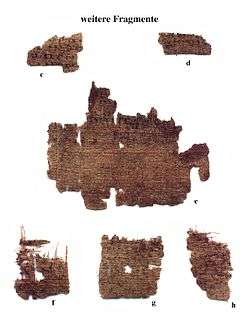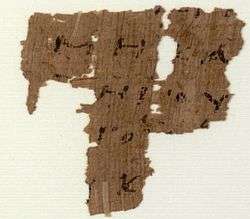Romans 2
Romans 2 is the second chapter of the Epistle to the Romans in the New Testament of the Christian Bible. It is authored by Paul the Apostle, while he was in Corinth in the mid 50s CE,[1] with the help of an amanuensis (secretary), Tertius, who adds his own greeting in Romans 16:22.[2] Although "the main theme of the Epistle [is] the doctrine of justification by faith", in verse 6 Paul "lays down with unmistakable definiteness and precision the doctrine that works, what a man has done, the moral tenor of his life, will be the standard by which he will be judged at the last day".[3]
| Romans 2 | |
|---|---|
 Fragment c to h containing parts of the Epistle to the Romans in Papyrus 40, written about AD 250. | |
| Book | Epistle to the Romans |
| Category | Pauline epistles |
| Christian Bible part | New Testament |
| Order in the Christian part | 6 |
Text
The original text was written in Koine Greek. This chapter is divided into 29 verses.
Textual witnesses
Some early manuscripts containing the text of this chapter are:
- Papyrus 40 (~250; extant verses 1–3)
- Papyrus 113 (3rd century; extant verses 12–13, 29)
- Codex Vaticanus (325–350)
- Codex Sinaiticus (330–360)
- Codex Alexandrinus (400–440)
- Codex Ephraemi Rescriptus (~450; extant verses 1–4)

Old Testament references
No partiality with God
Circumcision
Paul refers to circumcision as a physical mark of Jewish identity, but for a Jew who breaks the law it becomes a sign of contradiction: "your circumcision has become uncircumcision" (Romans 2:25). The prophet Jeremiah had spoken of those who were "circumcised yet uncircumcised" (Jeremiah 9:25, Holman Christian Standard Bible translation). Paul reiterates the teaching of Moses that:
He is a Jew who is one inwardly; and circumcision is that of the heart, in the Spirit, not in the letter
drawing on Moses' words in Deuteronomy 30:6:
The Lord your God will circumcise your heart and the heart of your descendants, to love the Lord your God with all your heart and with all your soul, that you may live.
See also
References
- Hill 2007, p. 1084.
- Donaldson, Terence L. (2007). "63. Introduction to the Pauline Corpus". In Barton, John; Muddiman, John (eds.). The Oxford Bible Commentary (first (paperback) ed.). Oxford University Press. p. 1077. ISBN 978-0199277186.
- Ellicott's Commentary for Modern Readers on Romans 2, accessed 5 September 2016
- Romans 2:11NKJV
Sources
- Coogan, Michael David (2007). Coogan, Michael David; Brettler, Marc Zvi; Newsom, Carol Ann; Perkins, Pheme (eds.). The New Oxford Annotated Bible with the Apocryphal/Deuterocanonical Books: New Revised Standard Version, Issue 48 (Augmented 3rd ed.). Oxford University Press. ISBN 9780195288810.
- Hill, Craig C. (2007). "64. Romans". In Barton, John; Muddiman, John (eds.). The Oxford Bible Commentary (first (paperback) ed.). Oxford University Press. pp. 1083–1108. ISBN 978-0199277186. Retrieved February 6, 2019.
- Moo, Douglas J. (1994). "Romans". In Carson, D. A.; France, R. T.; Motyer, J. A.; Wenham, G. J. (eds.). New Bible Commentary: 21st Century Edition (4, illustrated, reprint, revised ed.). Inter-Varsity Press. pp. 1115–1160. ISBN 9780851106489.
External links
- Romans 2 King James Bible - Wikisource
- English Translation with Parallel Latin Vulgate
- Online Bible at GospelHall.org (ESV, KJV, Darby, American Standard Version, Bible in Basic English)
- Multiple bible versions at Bible Gateway (NKJV, NIV, NRSV etc.)